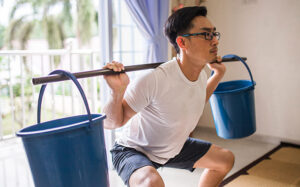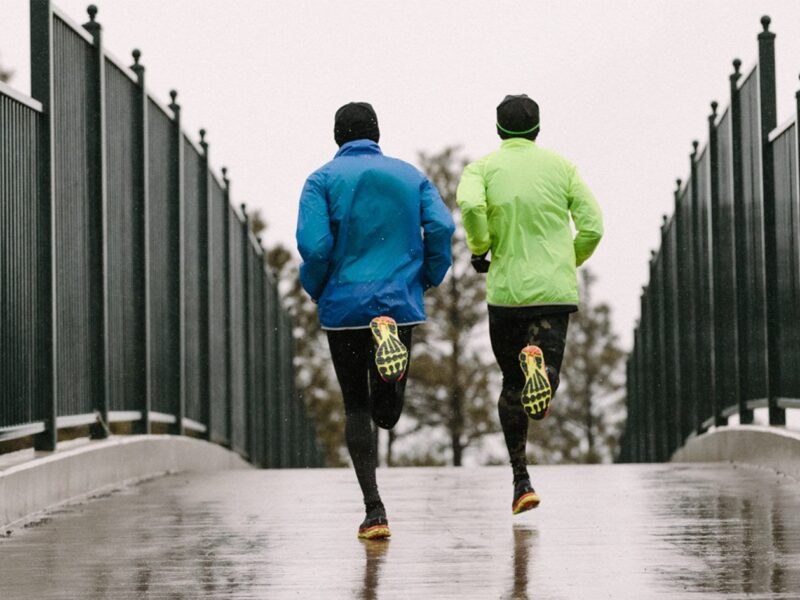When the skies open up and the rain pours down, it’s easy to let your fitness routine fall by the wayside. However, with a bit of creativity and ingenuity, you can turn your home into a personal gym using everyday household items. This guide will delve into a variety of exercises and techniques that leverage common objects found around the house, ensuring that you can stay active and fit without needing to step outside. Let’s explore the world of indoor fitness and how to make the most of what’s already in your home.

The Benefits of Home-Based Workouts
Before diving into specific exercises, it’s worth noting the numerous benefits of home-based workouts:
- Convenience: No need to travel to the gym or brave the elements.
- Cost-Effective: Save money on gym memberships and expensive equipment.
- Privacy: Exercise in the comfort of your own home, free from the eyes of others.
- Flexibility: Easily fit workouts into your schedule, even during short breaks.
Creative Use of Household Items
1. Chairs
Chairs are incredibly versatile for a range of exercises that target different muscle groups. Here are a few ways to incorporate chairs into your routine:
Tricep Dips
- How: Place your hands on the edge of the seat, fingers pointing forward, and extend your legs out in front of you. Lower your body by bending your elbows, then push back up.
- Why: Tricep dips effectively target the triceps, shoulders, and chest, helping to build upper body strength.
Step-Ups
- How: Stand in front of the chair. Step up onto the seat with one foot, then bring the other foot up to meet it. Step down and repeat.
- Why: This exercise is great for improving leg strength, coordination, and cardiovascular fitness.
Elevated Push-Ups
- How: Place your feet on the chair and your hands on the floor in a push-up position. Perform push-ups as usual.
- Why: Elevating your feet increases the difficulty of push-ups, intensifying the workout for your upper body and core.
2. Water Bottles and Cans
Water bottles and cans can be used as makeshift dumbbells for various strength training exercises.
Bicep Curls
- How: Hold a bottle or can in each hand with your palms facing forward. Curl your hands up towards your shoulders, then lower them back down.
- Why: Bicep curls help to build arm strength and muscle tone.
Overhead Press
- How: Hold the bottles or cans at shoulder height with palms facing forward. Press them overhead until your arms are fully extended, then lower them back down.
- Why: This exercise targets the shoulders and upper back, enhancing upper body strength and stability.
3. Towels
Towels can be used for both resistance exercises and as sliders for core workouts.
Towel Rows
- How: Loop a towel around a sturdy post or door handle. Hold the ends and lean back with your body straight. Pull yourself towards the anchor point, then slowly return to the starting position.
- Why: Towel rows are excellent for strengthening the back, biceps, and forearms.
Towel Mountain Climbers
- How: Place a towel under each foot and get into a plank position. Slide one knee towards your chest, then quickly switch legs as if you’re running in place.
- Why: This dynamic move targets the core, improves cardiovascular fitness, and enhances overall agility.
4. Backpacks
A backpack can be filled with books or other heavy items to create adjustable weights for various exercises.
Weighted Squats
- How: Fill a backpack with books, wear it on your back, and perform squats as usual.
- Why: Adding weight to squats increases the intensity, helping to build leg and glute strength more effectively.
Backpack Lunges
- How: With a weighted backpack on, step forward into a lunge, lowering your back knee towards the floor. Return to the starting position and repeat on the other side.
- Why: Lunges with added weight challenge your balance and coordination while strengthening your legs and glutes.
5. Stairs
Stairs provide a natural platform for a variety of cardiovascular and strength exercises.
Stair Running
- How: Run up and down the stairs at a steady pace, using the railing for support if needed.
- Why: Stair running is an excellent way to boost cardiovascular endurance and leg strength.
Calf Raises
- How: Stand on the edge of a step with your heels hanging off. Raise up onto your toes, then slowly lower your heels below the step level.
- Why: Calf raises are effective for strengthening the calf muscles and improving ankle stability.
6. Walls
Walls are great for static exercises that engage multiple muscle groups.
Wall Sits
- How: Stand with your back against the wall and slide down into a seated position with your knees at a 90-degree angle. Hold this position for as long as possible.
- Why: Wall sits are excellent for building endurance in the quadriceps, glutes, and core muscles.
Wall Push-Ups
- How: Stand facing a wall with your hands placed on it at shoulder height. Perform push-ups against the wall, maintaining a straight body line.
- Why: Wall push-ups are a great way to build upper body strength, especially for beginners or those with limited mobility.
7. Brooms and Mops
These household tools can be used for balance and stability exercises.
Broomstick Twists
- How: Hold a broomstick across your shoulders with both hands. Twist your torso from side to side, keeping your hips facing forward.
- Why: This exercise helps to improve core strength and rotational mobility.
Single-Leg Deadlifts
- How: Use a broomstick for balance as you perform single-leg deadlifts, hinging at the hips and lowering your upper body while lifting one leg behind you.
- Why: Single-leg deadlifts strengthen the hamstrings, glutes, and improve balance.
8. Beds and Sofas
Soft furniture like beds and sofas can be used for a variety of bodyweight exercises.
Incline Push-Ups
- How: Place your hands on the edge of the bed or sofa and perform push-ups.
- Why: Incline push-ups reduce the load on your upper body, making them easier and ideal for building strength gradually.
Glute Bridges
- How: Lie on your back with your feet on the edge of the sofa or bed. Lift your hips towards the ceiling, squeezing your glutes, then lower back down.
- Why: Glute bridges are great for strengthening the glutes, hamstrings, and lower back.
Structuring Your Rainy Day Workout
Now that we’ve explored various exercises using household items, let’s put them together into a structured workout plan. Here’s an example routine that you can follow:
Warm-Up (5-10 minutes)
- Marching in Place: Lift your knees high and swing your arms.
- Arm Circles: Extend your arms and make small circles, gradually increasing the size.
- Leg Swings: Hold onto a chair for balance and swing each leg forward and backward.
Strength Training Circuit (30 minutes)
Perform each exercise for 45 seconds, followed by a 15-second rest. Repeat the circuit three times.
- Chair Tricep Dips
- Water Bottle Bicep Curls
- Towel Rows
- Backpack Squats
- Stair Running
- Wall Sits
- Broomstick Twists
- Bed Glute Bridges
Core Workout (10 minutes)
- Towel Mountain Climbers: 1 minute
- Plank: Hold for 1 minute
- Single-Leg Deadlifts: 1 minute on each leg
- Bicycle Crunches: 1 minute
- Leg Raises: 1 minute
Cool Down (5-10 minutes)
- Stretching: Focus on all major muscle groups.
- Deep Breathing: Lie on your back and practice deep, slow breaths to relax.
Tips for Staying Motivated
- Set Goals: Establish clear, achievable goals to keep yourself motivated.
- Track Progress: Keep a journal or use a fitness app to log your workouts and progress.
- Mix It Up: Vary your routine to keep things interesting and challenge different muscle groups.
- Stay Accountable: Share your goals with a friend or join an online fitness community.
- Reward Yourself: Treat yourself for reaching milestones to maintain motivation.
Conclusion
Rainy days don’t have to mean the end of your fitness routine. With a little creativity, you can transform your home into a versatile gym using household items. These exercises not only provide an effective workout but also bring variety and fun to your fitness regimen. Embrace the challenge of indoor workouts, and let the rain be an opportunity to explore new ways to stay active and healthy. Remember, the key to staying fit is consistency, so keep moving, stay motivated, and enjoy the journey to a healthier you.










